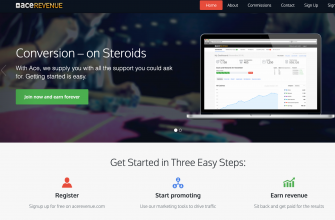Revenuelab – how to register?
Single point of contact
Don’t waste time dealing with the managers of each brand – our system, which brings together all the brands relevant to the market and provides you with a personal manager for all your questions, will be sufficient for you.
A powerful platform for monitoring performance and finances
Use our platform to make effective business decisions. The platform helps you analyse conversion rates, track player value, control cash flow from hundreds of brands, and pinpoint opportunities with hourly statistics updates.
Safe and flexible payments
We guarantee stability in payments.
Revenuelab Offers
We will select the best brands for you, based on the specifics of your traffic.
The choice of a payment model in the online gambling vertical should always be based on an analysis of the risk profile of your traffic, the need for turnover, etc. The CPA model keeps risks low but sharply limits your income, while Revenue Share (RS) and Hybrid (CPA+RS) models allow you to earn profits for years but have the chance to go in the red.
To understand which model to work with, let’s look at each one in great detail and then discuss what else to consider.
Which cooperation model should I choose?
CPA
Bottom line: CPA model is pay per action. In our case player who made the first deposit and qualified. Rates vary greatly depending on country, quality, and volume of traffic. The average payout for RU is $50-70. For the bourgeoisie, $100-250, but sometimes higher. We met the rates up to $ 600.
How it works: CPA payments are based on meeting KPIs or baseline, which can be
- Amount of player deposits (usually ≥ $5-20);
- Number of repeat deposits (usually 2 or 3);
- Wagering: A player must wager X times his deposit. For example, wagering x20 for a $10 FD means that the player has to bet $200, and then he will qualify;
- ROI (profit) of the traffic as a whole;
- Anti-fraud: if a player has multiple accounts (multi-accounting), similarity in behavioural patterns, etc.;
- Frequency of returning players and their behaviour: for example, the probability of lead uprooting is maximal if First Deposit (FD) to Return Deposit (RD) ratio is 1-1,5x in the first week, in the second 1,5-2x, and in the third 3x;
- Some advertisers limit the time in which conversion can occur from registration to deposit, for example, ten days;
- It is also worth noting that new conversions may fall on a hold period, after which the advertiser will decide whether to count them or not.
Of course, all the conditions do not apply at once: it is usually a combination of several. You have to be sure to dive into the nuances of each offer and try to pick the one where the traffic best matches the KPIs. It may be better to get less CPA, but more conversions counted than high CPA and rejected conversions. As the saying goes, less is better.
For example, an advertiser is willing to pay CPA=$120 for a player who contributes at least $25. It seems like a good deal for you, but the devil will be in the details. Let’s say the size of the first deposit turns out to be $20, and thus a relatively substantial percentage of your players will not qualify. It may well be that CPA=$100 and baseline=min.dep=$20 would be more profitable.
Pros:
- If the traffic qualifies, all the money is paid out at once – the risk of non-payment is reduced;
- You can immediately calculate the economics and decide whether or not it is profitable to cast: an ideal scheme for arbitrage.
Cons:
- Less risk, hence less potential profit. Good traffic is more profitable for the advertiser to buy back via CPA and get income from the big players – the high rollers, and you won’t get paid from that anymore;
- The advertiser may suddenly stop paying for your traffic, explaining this by deteriorating its quality.
Revenue Share
What’s the point: this payment model offers the webmaster a fixed percentage of the advertiser’s earnings. The leading beauty of this model is that it allows you to earn income until the players stop playing. We have accounts where the traffic was discontinued in 2014, but the % is still coming in! The average market rate is 30-50%, but you can see 60-80%.
How it works: Everything is based on the advertiser’s income, which is called Net Gaming Revenue or NGR. From the NGR we usually count our earnings (RS) as a percentage. But if there is Net Gaming Revenue, there has to be Gross Gaming Revenue (GGR), the attentive reader will think and he will be right. GGR is usually concealed by the advertiser (although there are exceptions) because it costs all sorts of royalties to game providers, white labels, processors, etc. These costs are packed into the so-called Admin Fee (AF), which is 35% on average in the market. From the GGR, the advertiser calculates the NGR using this simplified formula:
NGR = GGR – AF
If the player you invited makes a deposit of $1000 and loses it (AF takes 35%), then the NGR will be $650. Accordingly, your earnings as a percentage will be calculated from NGR ($650).
It is also worth mentioning such a trick as a Net Negative Carry Over (NNCO). Rolling in slots or roulette, players sometimes win. Sometimes a lot. What to do if you send traffic but your earnings are in deficit? Honestly, the % is a percentage, and as a rule, the minuses all close with time, but you become in a moment not so pleasant. To please their publishers, advertisers have come up with zeroing the balance. In general, this scheme is more profitable for you, but there’s not much difference. Why? Let’s understand how zeroing works?
Pervasive is the following scheme: when the minus balance of the player exceeds a certain threshold (say -$10.000) and the negative balance in your affiliate account (-$2000), the so-called high-roller policy is activated – the player is temporarily removed from your credit and will return only in case of complete recovery of minus. If the player was not removed and the minus was carried over, you would see a profit in the next period, when the player started losing. Usually, the big players will pour everything back in and return to your stats, so you shouldn’t worry too much about this.
Pros:
- The possibility of earning income over a time horizon of several years. Just like your passive;
- Earnings per player are higher than in other models. In other words, this scheme is the most profitable.
Cons:
- Profits are stretched over time. Not all and not all at once. Moreover, you may even see minuses, as if a player wins, it’s not in your favour;
- Poor retention rate and low profitability per player. The wasted traffic cannot be recovered;
- Risk A: Reduction of % by advertiser unilaterally, sometimes hidden by Admin Fee;
- Risk B: The advertiser may disappear or go bankrupt;
- Risk C: Licensing and other – the advertiser may disconnect and stop working with players in some GEOs.
Hybrid
What’s the point: this model assumes a combination of CPA + RS: more CPA part, less RS, and vice versa. Hybrids are not just handed out by advertisers, and they are usually the subject of agreements (we mean a well-balanced hybrid). Rates vary greatly by GEO, and on some GEOs, you can’t get them at all. Hybrids can vary greatly in face value even within the same source, depending on the amount of traffic or position on the site – they are an element of constant bargaining.
How it works: it’s worth emphasizing that all the same conditions for qualification work here, both for the CPA and RS model. So when discussing hybrid terms, don’t lose sight of these nuances!
In our opinion, hybrids are a balance of risk and profit, which is why we like them best. Yes, they are harder to mine but worth it.
For example, by converting transactions on one of our partners’ websites from RS to hybrids, we increased partner profits by 5%.
Choosing a model
When choosing a payment model, you need to take into account
- the need to replenish working capital;
- risk analysis;
- availability of the model to the advertiser.
If, as mentioned above, the need to generate turnover is what determines your choice, it is worth looking at CPAs. But if you don’t have a pressing need for turnover, you can risk working with % rates. You’ll get less at the moment but usually more in the long run. If you decide to go down the second route, risks arise. The main risks are changing the rules for a particular country and downgrading the deal.
Country risk
By generating traffic predominantly in one country, you risk getting licensed if the country was a grey market and suddenly became a white market. The operator may nullify your player base due to the inability to continue working with them. If the GEO is operating without a license, there may be complicating regulations for operators. There may be problems with processing and bans and the operator may even leave the problematic GEO. Naturally, your player base may be lost.
Such cases have already happened more than once. Australia, Sweden, Switzerland, Holland, Italy, Spain, and other countries have closed down. And some operators have completely stopped working with GEO data and zeroed out the payouts. A recent case comes to mind with EMU partners who took and stopped accepting Australian traffic. It was stated that the old players would continue to play, but the payouts dropped dramatically.
Downgrade deal
The operator can cut you off the % on the deal if your traffic drops or you don’t meet the conditions. Or they can cut your payout or big players so that you don’t even notice. It’s worth noting that the risk of evil behaviour increases if your traffic suddenly drops.
It’s also worth mentioning the staggering rates (you send more, you earn more). Don’t forget: tariffs also work in reverse. If you receive less traffic from your existing player base, they will lower your profit percentage legally, as it’s stated in the terms and conditions. Always read the terms and conditions! Advertisers are very keen on negotiating with their partners by decreasing their rates.
The principle of reducing both risks was formulated a long time ago and not by us: do not put your eggs in one basket.
The country risk reduces the availability of sources in different GEOs and monitoring news background and rumours to predict the development of the situation. The CPA model is a radical solution, but advertisers stop using it if the risks are apparent.
The risk of deal failure is reduced by diluting the traffic across multiple advertisers. It’s perfect to split traffic between long-established and well-established advertisers. With new and untested ones, you have to be extremely careful and dose the amount of traffic according to percentage models. All terms and conditions of the offer should always be agreed in detail.
Conclusions and feedback
And the main thing is risk management. You can’t manage the advertiser, but you can manage yourself, and by your competent actions, you can increase your earnings and reduce your losses. Therefore:
- keep up to date with news, anticipate events, redirect traffic in the best possible way;
- assess risks and be disciplined about putting traffic into different baskets;
- use hybrids where possible;
- Check terms and conditions with the advertiser thoroughly. This applies to all payment models.
RevenueLab specialises in this kind of work. We follow the news, assess our partners’ risks, negotiate unique hybrids and CPAs, and ensure that terms and conditions on rates don’t go down.
We hope you found this helpful article.
Big money to you all!









